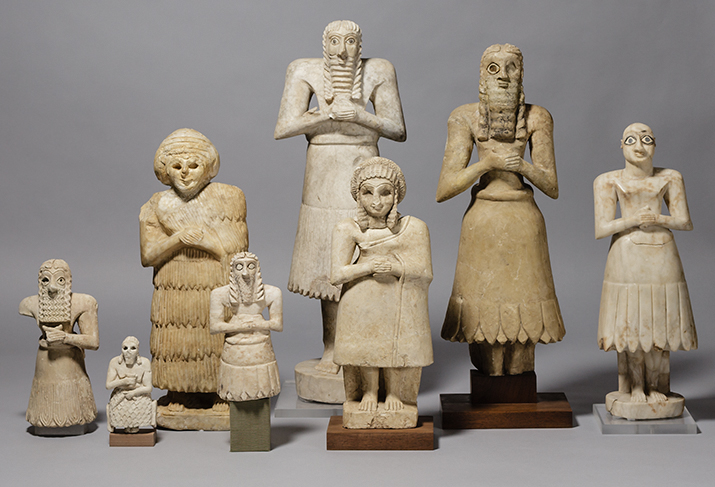Michael Rakowitz: The Invisible Enemy Should Not Exist
The Edgar and Deborah Jannotta Mesopotamian Gallery
March 18 – May 25, 2014
The Invisible Enemy Should Not Exist (2007 to present) unfolds as an intricate narrative about the artifacts stolen from the Iraq Museum, Baghdad, in the aftermath of the US invasion of April 2003; the current status of their whereabouts; and the series of events surrounding the invasion, the plundering, and related protagonists. The centerpiece of the project is an ongoing series of sculptures that represent an attempt to reconstruct looted and stolen archaeological artifacts.
The title takes its name from a translation of Aj-ibur-shapu, the ancient Babylonian processional way that ran through the Ishtar Gate in Babylon. Drawings (featured on a pamphlet accompanying the exhibit) tell the story of how the gate was excavated in Iraq in 1902–1914 by German archaeologist Robert Koldewey. Glazed bricks from the gate and processional way were used (alongside modern bricks) to create an architectural reconstruction in Berlin. Later reconstructions at the ancient city of Babylon were created by Saddam Hussein as a monument to his own sovereignty. A reconstructed Ishtar Gate at Babylon has been frequently photographed and posted on the Internet by US servicemen recently stationed in Iraq.

Two of the Diyala statues reconstructed by Rakowitz.
The reconstructions in Rakowitz’s work are made from the packaging of Middle Eastern foodstuffs and local Arabic newspapers, moments of cultural visibility found in cities across the United States. The objects were created together with a team of assistants who used the Oriental Institute of the University of Chicago’s 2003 “Lost Treasures of Iraq” database as a resource, as well as information posted on Interpol’s website.
“Lost Treasures of Iraq” was launched in April 2003 after the looting and ransacking of Iraq's National Museum and Library. In addition to materials from the Oriental Institute’s own expeditions its database included photographs and object descriptions supplied by scholars, expeditions, and archives from all over the world. At a time when the true extent of Iraq's war-related losses was unknown, "Lost Treasures" attempted to document what was known about Iraq's museum collections and library collections to help law enforcement and custom officials in the recovery of missing items. Subsequent inventories confirmed that numerous pieces listed on "Lost Treasures" were either missing, damaged, or destroyed during the looting. Although many pieces were accounted for or recovered later on, thousands of items still remain at large.

Male and Female Statues. Gypsum. Early Dynastic period (ca. 2750–2500 BC). Iraq, Diyala Region. Excavated by the Oriental Institute and on display in the Oriental Institute Museum.
The items represented by Rakowitz are a selection of all of the above: some are safe or are being restored, while others remain lost or in pieces. The reconstructions, including some new artworks, are displayed immediately opposite the original statues from the Oriental Institute’s collection, which were part of an original formal division with the Iraq Museum in the late 1920s–1930s. Reunited yet still divided, the reconstructed statues and their original counterparts stand face-to-face in the Mesopotamian gallery.
This exhibit is part of an ongoing commitment to recuperate the thousands of objects that are still missing. It coincides with the eleventh anniversary of the looting of the Iraq Museum (April 10–12, 2003). It is also an opportunity to remember the life and work of Donny George (1950–2011), former director of the Iraq Museum and tireless campaigner for the heritage of Iraq.
Artist's Talk by Michael Rakowitz on this installation: May 21, 6.00-7.00 PM. Free. Find out more and book here.
Notes:
- A translation of Aj-ibur-shapu more generally accepted in recent times (following the Chicago Assyrian Dictionary) is "may the enemy not remain healthy."
- The Oriental Institute's "Lost Treasures of Iraq" database was compiled by Clemens Reichel (then Research Associate) and Charles E. Jones (then Head Librarian, Research Archives) in collaboration with McGuire Gibson (Professor, Mesopotamian archaeology).

